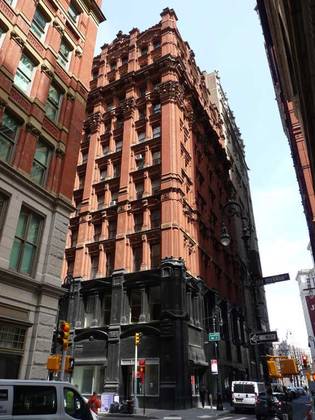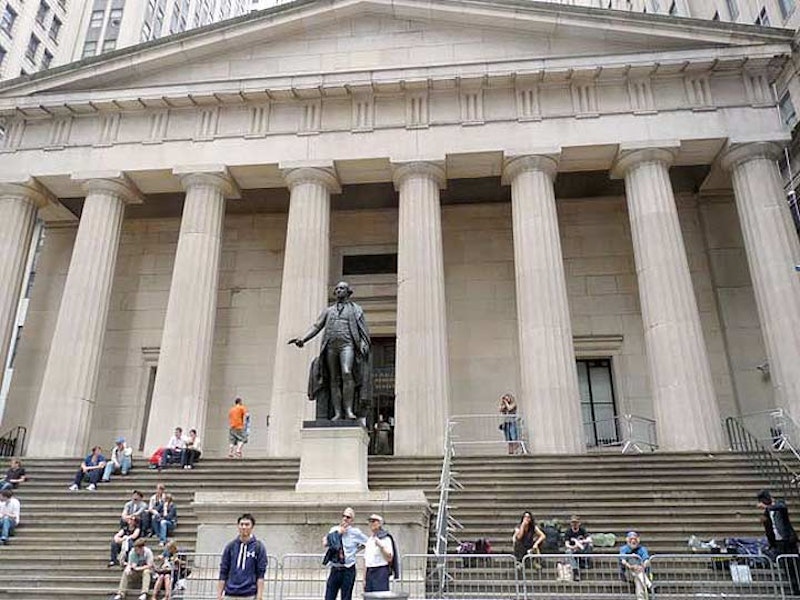When New York City was still subject to the British Crown there were a number of streets downtown named Queen, Duke, and other royal titles. Almost all of them were wiped off the map after the USA won independence in 1783 and the British evacuated the country and NYC in particular. Queen became Pearl, King George St. became William (for early NYC mayor William Beckman), Crown became Liberty, and so forth. There are a couple still around, though—Prince St. in Soho is one, and Nassau St. is another.
Nassau St. was named by 1696 for the House of Orange-Nassau in the Netherlands, which extended back to Charlemagne. King William III of England, the person for whom the street name was bestowed, became king in 1689 and was Dutch by ancestry; his wife, Mary, was British. William’s army had forced Mary’s father, King James II, out of power. Dutch royalty remains to this day in the House of Orange-Nassau.
The first building seen when walking north on Nassau St. from Wall is Federal Hall, completed in 1842. This building replaced the second NYC City Hall, built here in 1700 and later remodeled in 1788-1789 (by Pierre L’Enfant, the architect/urban planner who laid out Washington, DC) when it became the first United States Capitol building, a function it held for one year. George Washington took his oath of office as President at that building. It came to be called the original Federal Hall.
The old Federal Hall gradually fell into disuse and disrepair, and was sold and subsequently demolished in 1812. Thirty years later, in 1842, the United States Customs House was built on the spot, joining the likewise Greek Revival U.S. Assay Office that was built from 1823-1826. The old Assay Office was demolished in 1915, but it’s still recalled by a sidewalk plaque, and its façade was dismantled and later reconstructed in the Metropolitan Museum on 5th Ave.

On the northwest corner of Nassau and Liberty is the one-time Sinclair Oil Building. Sinclair used a dinosaur as its mascot, and tall, stylish masonry towers coated with terra cotta like this are dinosaurs in their own right, as most towers built these days are glass-fronted (making them especially vulnerable to windstorms such as Sandy). Later called the Liberty Tower, it was converted to apartments in 1981. Finished in 1910, it seems now like a dry run for the nearby taller Woolworth Tower that came along in 1913. At the entrance, there’s a pair of alligators trying to shinny up the building.
After running and losing for Vice President in 1920, Franklin D. Roosevelt worked in this tower for the Fidelity and Deposit Company before entering public life again as New York’s governor and a four-term president.

By some accounts, this building, at 63 Nassau St., south of John St., was built in the 1860s by an early giant of cast iron architecture, James Bogardus (1800-1874). His use of cast iron to cover building exteriors later led to steel-frame construction. In Soho, you’ll find dozens of distinctive buildings with such cast-iron cladding. A short street near Fort Tryon Park in far upper Manhattan is named for Bogardus, far from his architectural innovations.
Note 63 Nassau’s patriotic depiction of Ben Franklin. The empty spaces between the two Franklins on 63 Nassau St. used to contain two similar portraits of George Washington. How or why did Washington disappear? Sloppy renovation, I suspect. A monumental statue of Franklin can be found at the north end of Nassau St. at Park Row at the region formerly known as Newspaper Row, and Franklin, a printer himself, was chosen to emblemize the area.

Back in the 1870s, incredible edifices were built. This one took 20 years to get right. The Bennett Building, on the NW corner of Fulton and Nassau, was six stories with a mansard roof when first built, was raised to 10 stories in 1888, and extended north to Ann St. by 1891. There’s a texture here with the recessed front windows and curved corner windows that can’t be matched by today’s glass boxes. The Bennett family produced James Gordon Bennett, who ran the New York Herald; Bennett sent reporter Henry M. Stanley to Africa to find missionary/explorer/abolitionist David Livingstone in 1871.

Completed in 1886 [Norris Starkweather, arch.], the Potter Building was one of the first towers in Manhattan to extensively employ terra cotta on its facade. It was preceded by the headquarters of the New York World newspaper, which burned down in a scene vividly recounted in Jack Finney’s fantasy novel Time and Again. The Potter Building was also the first NYC building to be thoroughly fireproofed (by its developer Orlando Potter).

At the southwest corner of Nassau, Temple Court (or #5 Beekman) has been called one of NYC’s lost treasures. Completed in 1883, it joins the Potter Building as an early adopter of fireproof building methods. Amazingly, its nine-floor atrium with cast-iron balustrades was completely abandoned for many years. It’s redeveloped now, after years of neglect. The building was built by banker/Irish immigrant Eugene Kelly, who’d amassed the 19th-century equivalent of $630 million by the time he died.

Pace University fronts on a closed section of Nassau St. just before it reaches Park Row. It was founded in 1906 by brothers Homer St. Clair Pace and Charles Ashford Pace. The school originally rented rooms in the now-demolished New York Tribune Building on Park Row. Ground was broken for the current campus, One Pace Plaza, in 1966. Pace was approved for university status by the NYS Board of regents in 1973. The University has bought other space in lower Manhattan and also has a campus in upstate Pleasantville. Pace has about 950,000 square feet of space in Lower Manhattan.
—Kevin Walsh is the webmaster of the award-winning website Forgotten NY, and the author of the books Forgotten New York (HarperCollins, 2006) and also, with the Greater Astoria Historical Society, Forgotten Queens (Arcadia, 2013)

